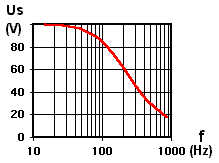Here you can find unfamiliar terms that are used on our site, click on a word to see its description:
White noise
Random noise which has the same power spectral density in all frequencies. Because white light is the one which has all the frequencies of the visible spectrum, white noise gets its name from containing also all the frequencies.
White noise is a not corresponding signal, in other words, in the "time" axis the signal takes its values without any relation whatsoever between them. Normally we use these as test signals, although "Pink noise" is prefered.
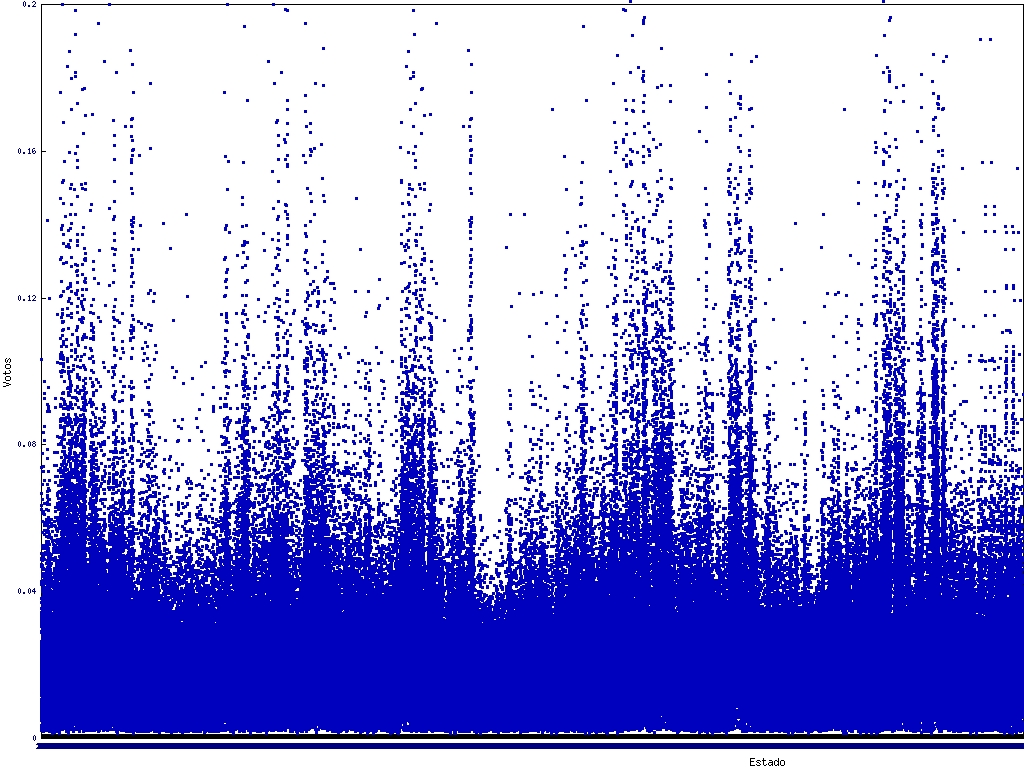
Pink noise
Random noise which has the its power spectral density in direct relation with its frequency (=1/f). Its name derives from being somewhere in the middle of "White noise" (1/1) and "Red noise" (1/f^2). "Pink noise" has the same energy in all octaves. This is why its energy decays 3dB for each octave. When heard, it seems somewhat darker than "white noise"; white noise, however, does not decay; while red noise decays 6dB for each octave.By analyzing a Fourier decomposition of Pink noise and seeing the graphic of the frequencies, it looks like a descending ramp; thus descending the more we go to the right.
In the audio world, pink noise is widely used; because its spectrum resembles the majority of harmonic instruments, and because the majority of graphics are used in a logarithmic scale (graded in octaves). In the horizontal axis, pink noise looks like it had a flat spectrum.
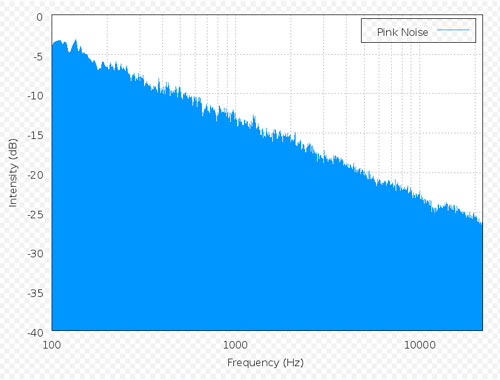
This is a way of measuring how precise a system is when playing sounds. When it comes to audio, it is better if it has a range from 20 to 20,000Hz. The range is larger in the vast majority if electronic amplifiers. This standard is not complied by CD players that instead use a bad anti aliasing filter or that to not have oversampling, which start decaying before 20kHz. Speakers do not comply with this either, those of low quality can't do 20Hz nor 20kHz. Those of high quality, can make it to 20kHz but need a large woofer to lower down to 20Hz. The window in which frequency response moves is also fundamental. Speakers that have a curve with a mean value that varies more than +/- 3dB between the cutoff frequency of a Anechoic Chamber (capable of absorbing sound waves without bouncing them), or more precisely, Schroeder's frequency in this chamber and 20kHz (the theoretic limit of our hearing range).
The ones with a mean value that varies between +/-1 or, even better, +/-0.5 are considered of very high quality.
Crosstalk
When a audio signal slips from one channel to another, in other words, when a voice or an instrument recorded in the right channel or the left channel, something from one channel goes into another. The opposite process is channel separation.
Crosstalk is usually measured in decibels. In practice, even if the decibels are too low, as low as -20 or -30dB, you will still obtain an excellent stereo channel separation. The important thing is that this does not vary in frequency range, because that would cause inconsistency between the fundamental frequency and its different harmonics, thus altering the tones.
Reverberant Field
Also called "Reflected Field". In acoustics it includes the sounds from the source, but that have been bounced off walls or objects.
In electro acoustics, the speakers, including those of high fidelity, tend to have a larger "sweet spot" and produce a wider and deeper stereo image. This effect is maximized in omni directional speakers.
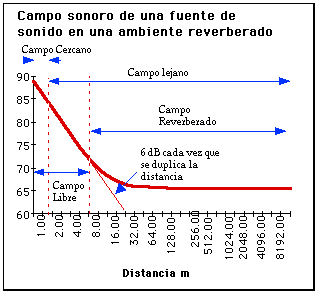
Distortion
It's a vagueness in the recording, transmission or reproduction of a signal. In the audio world, different types of distortion exist: harmonic distortion of the base frequency, inter modulation distortion, non-lineal distortion and zero crossing distortion; caused by noise and variation in frequency response.
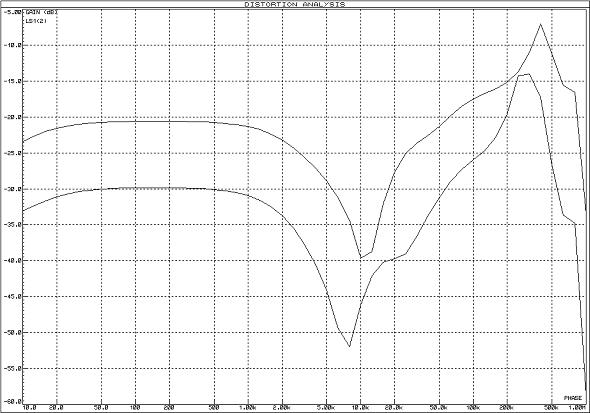
Sweet Spot
Hearing position or positions where you get a better subjective perception of the quality of the sound. Normally, it
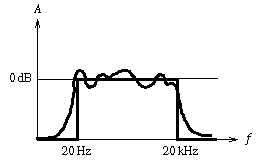 Audio band: Interval of the sounds whose frequency consists between 20Hz and 20000Hz, they are the sounds perceived by the human hearing.
Audio band: Interval of the sounds whose frequency consists between 20Hz and 20000Hz, they are the sounds perceived by the human hearing.
Dynamics: It corresponds to the proportion among the maximum and minimum intensity of the sounds that one can reproduce. With 90dB, or the proportion of 109, the compact disc arrives to the dynamics of a symphonic orchestra in a room of good acoustics.
Sign to noise Ratio: It corresponds to the proportion among the maximum intensity that the useful sign can take and the level of the bottom noise (it is the breathing that one sometimes listens) . Another time with 90dB one arrives thoroughly to the conditions of a classic concert.
Comments:The Real Sign to Noise Ratiois unfortunately very often either on the theoretical capacity of the compact disc. Indeed, the engineers of the sound make a mixage too much often worked, they don't adjust the level of the mics properly, they recorded in a noisy environment.
Harmonic distortion: This measure, expressed in percentages, demonstrates the change of the harmonic curves that composes the sign. It can happen among other, in the event of the saturation during a sound recording, the sinusoidales transforms then into a square sign. The harmonic distortion is lower to 0.004% for the compact disc.
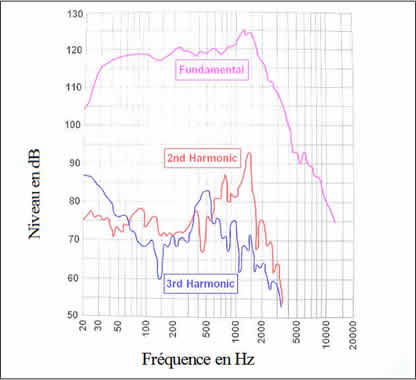
Zero Crossing Discontinuity: More briefly known "crossover distortion". A small discontinuity in the output signal when a transistor-based circuit passes through zero, ie when one is active and the other is off, and vice versa.
Intermodulation Distortion: If two tones are played at once, they can interact on the computer and also produce other new tones, which are the sum and the difference of the two original tones. Generally, new tones are non-harmonic to each other or with those before. In other words, when a signal passes through a nonlinear system that new tones are created.

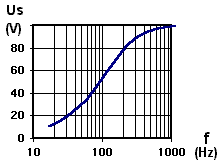 Filter: The filtering of a signal is to eliminate some of its spectral components, for example the higher frequencies at a frequency fmax. In this particular case one will say that one uses a low pass filter (right), and fmax is called the filter cutoff frequency (fc). One defines a filter in passing high in a similar (to the left) way. The superior (or inferior of agreement with the filter) frequencies to the frequency that fmax (fmin) is not eliminated brutally, but progressively, when they take away from the court.You can then specify the slope of the cut, and we say such a low pass filter cutoff frequency of 20kHz has a slope of 12dB per octave
Filter: The filtering of a signal is to eliminate some of its spectral components, for example the higher frequencies at a frequency fmax. In this particular case one will say that one uses a low pass filter (right), and fmax is called the filter cutoff frequency (fc). One defines a filter in passing high in a similar (to the left) way. The superior (or inferior of agreement with the filter) frequencies to the frequency that fmax (fmin) is not eliminated brutally, but progressively, when they take away from the court.You can then specify the slope of the cut, and we say such a low pass filter cutoff frequency of 20kHz has a slope of 12dB per octave
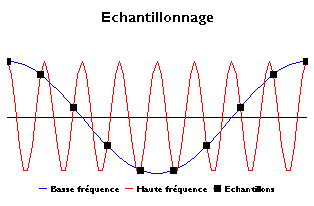
Sampling: The sampling of a sound signal is to select only certain points of the curve amplitude / time, to minimize the amount of information stored. If these points can be chosen periodically, the sampling is uniform then, if not, otherwise. This type of signal that we want to sample that will determine how to select these samples. The only goal is to reconstruct the signal from samples
 Theorem of Shannon: It states that the sampling frequency of a signal must be equal or greater than twice the maximum frequency contained in that signal to convert the signal from analog form to digital form. This theorem is the basis for converting digital signals.If the sampling frequency is less than twice fmax then we can not recover the signal without distortion due to the phenomenon of folding when the spectra of inverse Fourier transformation. We find this course when sampling a signal at a frequency fe = 2fmax and if its spectrum extends beyond the maximum frequency fmax assumed.t is therefore essential to filter the message with a low pass filter cutoff frequency fmax. The sampling frequency of CD is 44.1kHz
Theorem of Shannon: It states that the sampling frequency of a signal must be equal or greater than twice the maximum frequency contained in that signal to convert the signal from analog form to digital form. This theorem is the basis for converting digital signals.If the sampling frequency is less than twice fmax then we can not recover the signal without distortion due to the phenomenon of folding when the spectra of inverse Fourier transformation. We find this course when sampling a signal at a frequency fe = 2fmax and if its spectrum extends beyond the maximum frequency fmax assumed.t is therefore essential to filter the message with a low pass filter cutoff frequency fmax. The sampling frequency of CD is 44.1kHz
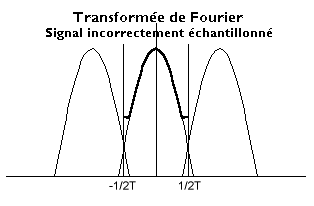
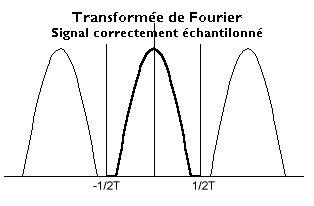
DAC: is a device for converting a digital (usually binary) code to an analog signal
ADC: is a device which converts continuous signals to discrete digital
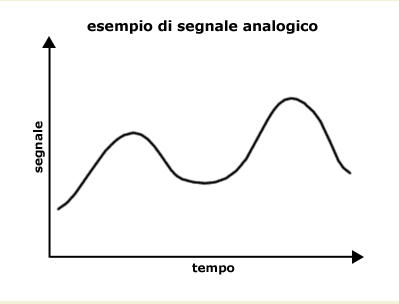
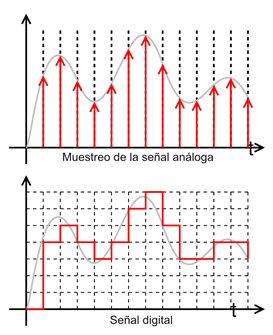
DSP: A digital signal processor is a specialized microprocessor with an optimized architecture for the fast operational needs of digital signal processing
Digital signal processing algorithms typically require a large number of mathematical operations to be performed quickly on a set of data. Signals are converted from analog to digital, manipulated digitally, and then converted again to analog form, as diagrammed below. Many DSP applications have constraints on latency; that is, for the system to work, the DSP operation must be completed within some time constraint.

Amplifier: is any device that changes, usually increases, the amplitude of a signal. The relationship of the input to the output of an amplifier—usually expressed as a function of the input frequency—is called the transfer function of the amplifier, and the magnitude of the transfer function is termed the gain.
In popular use, the term usually describes an electronic amplifier, in which the input "signal" is usually voltage or current. In audio applications, amplifiers operate loudspeakers used in PA systems to make the human voice louder or play recorded music. Amplifiers may be classified according to the input (source) they are designed to amplify (such as a guitar amplifier, to perform with an electric guitar), the device they are intended to drive (such as a headphone amplifier), the frequency range of the signals (Audio, IF, RF, and VHF amplifiers, for example), whether they invert the signal (inverting amplifiers and non-inverting amplifiers), or the type of device used in the amplification (valve or tube amplifiers, FET amplifiers, etc.).
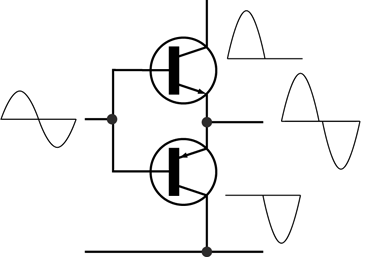
D class Amplifier: In the Class D amplifier the input signal is converted to a sequence of higher voltage output pulses. The averaged-over-time power values of these pulses are directly proportional to the instantaneous amplitude of the input signal. The frequency of the output pulses is typically ten or more times the highest frequency in the input signal to be amplfied. The output pulses contain inaccurate spectral components (that is, the pulse frequency and its harmonics) which must be removed by a low-pass passive filter. The resulting filtered signal is then an amplified replica of the input.
The main advantage of a class D amplifier is power efficiency. Because the output pulses have a fixed amplitude, the switching elements (usually MOSFETs, but valves and bipolar transistors were once used) are switched either completely on or completely off, rather than operated in linear mode. A MOSFET operates with the lowest resistance when fully-on and thus has the lowest power dissipation when in that condition, except when fully off. (When operated in a linear mode the MOSFET has variable amounts of resistance that vary linearly with the input voltage and the resistance is something other than the minimum possible, therefore more electrical energy is dissipated as heat.) Compared to class A/B operation, class D's lower losses permit the use of a smaller heat sink for the MOSFETS while also reducing the amount of AC power supply power required. Thus, Class D amplifiers do not need as large or as heavy power supply transformers or heatsinks, so they are smaller and more compact in size than an equivalent Class AB amplifier.

Impedance(Z): describes a measure of opposition to alternating current (AC). Electrical impedance extends the concept of resistance to AC circuits, describing not only the relative amplitudes of the voltage and current, but also the relative phases. When the circuit is driven with direct current (DC) there is no distinction between impedance and resistance; the latter can be thought of as impedance with zero phase angle.

